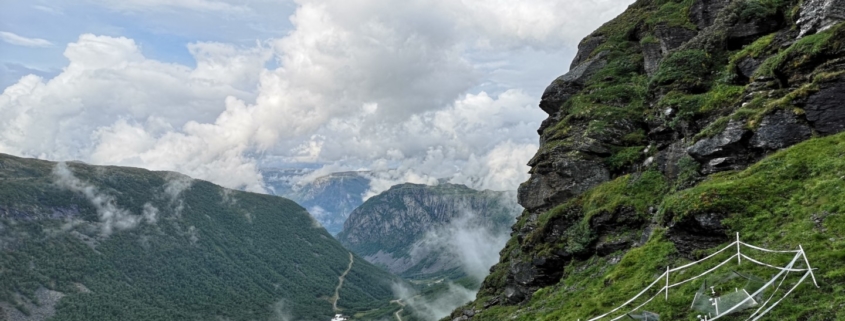7th Conference on Modelling Hydrology, Climate and Land Surface Processes – presentasjoner
Modelling, forecasting, communicating, and handling weather-induced natural hazards
Lillehammer, 19 – 21 September 2023
See the final programme
See the abstracts
See the programme with links to the abstracts
See the presentations
CONFERENCE THEME
Disasters from natural hazards are growing at a rapid rate across the world for several reasons. Population growth, migration and urbanization make people occupy land that is more exposed to severe and frequent threats. In addition to being more exposed to hazards, these communities are often more vulnerable, lacking the ability and means to mitigate and adapt to natural hazards. In the Global Risk Report 2022, provided by the World Economic Forum, environmental risks are perceived to be among the most critical long-term threats to the world.
Extreme weather events, as well as the number of people exposed to hazardous weather conditions and their consequences are increasing, also in Norway, and the extent of climate related damages has increased in the last ten years. Developing strategies to cope with natural hazards and their associated impacts, require us to pay attention to all parts of the value chain: modelling, forecasting, and communication of weather-induced natural hazards. Natural hazards are environmental phenomena that have the potential to impact societies and humans, including earthquakes, tsunamis, and volcanoes. In this conference, the focus is on hydrometeorological hazards. Examples of such hazards are extreme precipitation, floods, droughts, landslides, and snow avalanches.
Session 1: Methods and models for natural hazard prediction, including machine learning
Keynotes: Matthew Chantry, ECMWF; Berit Arheimer, SMHI
Models for prediction of natural hazards are in continuous development, partly as a response to increasing availability of data products for forcing and updating. In session 1, we welcome contributions on new developments within physical/conceptual or data-driven modelling techniques, as well as methods and strategies for empirical model adaptation beyond traditional single-catchment calibration. Multi-hazard modelling concepts are particularly welcomed, including but not restricted to floods, droughts, landslides, and snow avalanches. Also highly welcomed are studies on models being used for large regional domains, for which direct calibration to known responses (e.g., peak discharge) is less applicable.
Session 2: Forecasting of weather-induced natural hazards, including data assimilation
Keynotes: Steven Cole, CEH; Kolbjørn Engeland, NVE
Several natural hazards can be predicted from weather conditions, and thus be forecasted using weather prediction models either directly or as input to hydrologic and other hazard models. In session 2 we welcome contributions based on experiences with such forecasting systems, quality assessments of their forecasts, and the use of observations in the prediction making. Topics may include evaluation for multiple responses and purposes, methods for assimilating observations or otherwise combining forecasted and measured information, quantifications of uncertainty for different lead time, or related other themes.
Session 3: Impact-based natural hazard warnings: User needs and risk communication
Keynotes: Kerstin Stahl, Univ. Freiburg; Juhana Hyrkkänen, FMI
WMO emphasizes the need for improved early warning systems that facilitate early actions: “forecasts of what the weather will BE are no longer enough. Impact-based forecasts on what the weather will DO and what people should do are vital to save lives and livelihoods”. In session 3, we welcome contributions on some of the key issues for taking the next steps toward implementing impact-based warnings: how to build partnerships with a range of stakeholders, how to collect impact information (e.g., societal consequences of the natural hazard), and insight into users’ needs, perceptions, and thoughts. Further, these experiences can be beneficial in communication of hazard information to the public with the requested clarity and trust to make it actionable.
Session 4: Dimensioning and planning for natural hazard risks, including climate change issues
Keynotes: Øyvind Paasche, Norce; Torbjørg Austrud, Voss municipality
The extent of climate related damages in Norway has increased in the last ten years, and extreme precipitation is causing half of the compensation. Nevertheless, a recent report from the office of the Auditor General of Norway, criticizes the authorities for not having implemented the necessary measures to secure existing buildings and infrastructure. On the other hand, many local communities are restricted from permitting construction and refurbishing on hazard-prone zones, even where these overlap with existing built-up areas. Session 4 welcomes contributions on risk estimation, identification and delineation of hazard zones, and structural and non-permanent mitigation.
Conference fee: NOK 3900,-
The conference fee covers registration, abstract management, and technical solutions, and includes:
3 x lunch, 2 x dinner (including Banquet), social events and conference materials.
Accommodation and breakfasts are not included in the conference fee.
Students in Norway can apply support from the Norwegian Hydrological Council for their participation. Please find the application form here.
Venue:
Scandic Victoria Lillehammer, Nymosvingen 3, Lillehammer, Norway
ORGANIZING AND SCIENTIFIC COMMITTEE
Sjur A. Kolberg, Norwegian Water Resources and Energy Directorate (chair)
Ole Einar Tveito, Norwegian Meteorological Institute and Norwegian Hydrological Council
Lu Li, NORCE Norwegian Research Centre
Anders Doksæter Sivle, Norwegian Meteorological Institute
Håkon Sundt, SINTEF Energi
Trine Jahr Hegdahl, Norwegian Water Resources and Energy Directorate
Lena M. Tallaksen, University of Oslo
Anne Haugum, Norwegian Hydrological Council
Website: https://www.hydrologiraadet.no/7th-conference-on-modelling-hydrology-climate-and-land-surface-processes/



